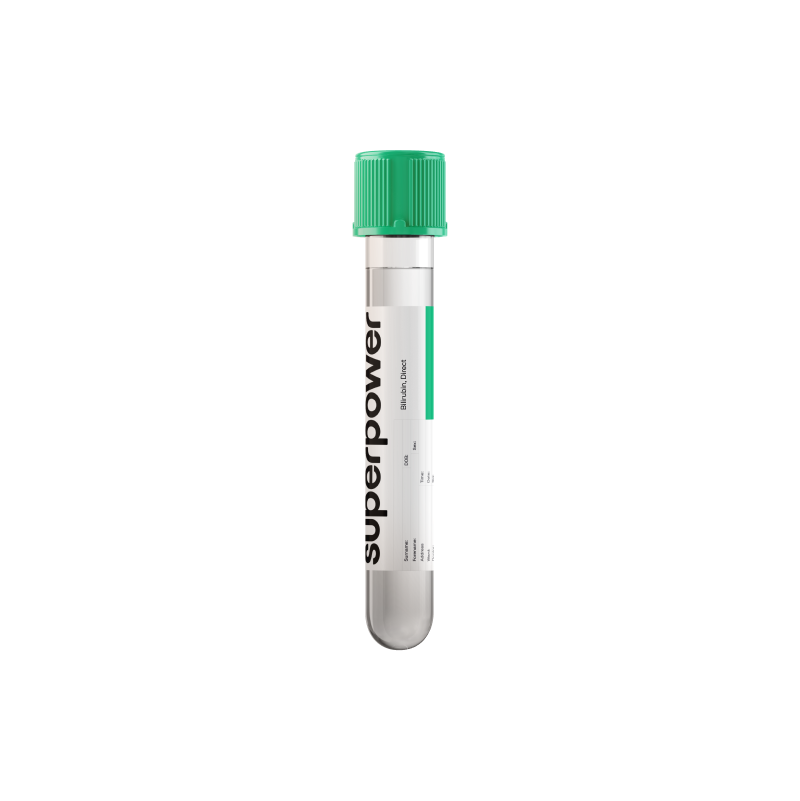Get precise insights into bile flow, liver function, and recovery by tracking conjugated bilirubin patterns.
Key Benefits
Spot bile flow problems by measuring the conjugated (direct) bilirubin in blood.
- Flag blocked bile ducts from gallstones, strictures, or tumors that elevate direct bilirubin.
- Explain jaundice, dark urine, or pale stools by pinpointing cholestasis versus hemolysis.
- Guide next steps, like ultrasound, bile duct imaging, medication review, or urgent referral.
- Track liver recovery after hepatitis, bile duct procedures, or treatment for cholestatic disease.
- Clarify drug-induced liver injury by identifying a cholestatic pattern of liver test changes.
- Support newborn care by flagging pathologic direct hyperbilirubinemia needing prompt evaluation.
- Best interpreted with total bilirubin, AST/ALT, ALP, GGT, and your symptoms.
What is Bilirubin, Direct?
Direct bilirubin is the water‑soluble form of bilirubin that the liver has finished processing. Bilirubin itself is a yellow pigment created when worn‑out red blood cells are dismantled and heme is converted to bilirubin in macrophages. That first form travels to the liver bound to albumin (unconjugated/indirect bilirubin). In liver cells (hepatocytes), an enzyme adds glucuronic acid (glucuronidation by UGT1A1), producing conjugated bilirubin—mainly bilirubin diglucuronide. This conjugated, water‑soluble fraction is what is called direct bilirubin.
Direct bilirubin represents the “ready for disposal” bilirubin that hepatocytes secrete into tiny bile channels (bile canaliculi) and then into the bile ducts. It is the finished product of heme breakdown prepared for delivery to the intestine, where it is transformed and eliminated. As such, direct bilirubin reflects the liver’s ability to package bilirubin safely for excretion (conjugation) and to move it out with bile (biliary excretion). It is a practical signpost of how well the liver’s processing line and the bile drainage pathway are working.
Why is Bilirubin, Direct important?
Direct (conjugated) bilirubin is the water‑soluble form your liver makes after processing hemoglobin’s breakdown products. It travels with bile into the intestine. Because it reflects both liver cell handling and bile flow, it’s a sensitive readout of hepatobiliary health and how well you’re moving waste out of the body.
Typical direct bilirubin is very low—often under about 0.3—and it’s a small slice of total bilirubin (usually under 20–30%). Values toward the low end are generally optimal, indicating intact conjugation in hepatocytes and unobstructed bile drainage.
When direct bilirubin is very low or undetectable, that simply means efficient processing and excretion. It doesn’t cause symptoms and isn’t clinically worrisome. There aren’t meaningful differences by sex. In pregnancy and childhood, low values carry the same benign interpretation.
Higher direct bilirubin signals conjugated hyperbilirubinemia: the liver is conjugating bilirubin, but excretion into bile or flow through the ducts is impaired (cholestasis) or hepatocytes are inflamed. People may notice yellowing of skin/eyes, dark urine (because conjugated bilirubin is water‑soluble and spills into urine), pale stools, itching, fatigue, and right‑upper‑abdomen discomfort. Persistent elevation can hinder fat and fat‑soluble vitamin absorption, affecting bone and blood‑clotting health. Patterns vary: obstruction from gallstones or tumors, cholestatic drug effects, viral or autoimmune hepatitis, or cirrhosis. In newborns, a raised direct fraction—especially if jaundice lasts beyond the early weeks—points away from common physiologic jaundice and toward cholestasis. In pregnancy, cholestatic disorders can raise the direct fraction.
Big picture: direct bilirubin links red‑cell turnover, hepatocyte function, bile duct patency, kidneys (dark urine), and gut metabolism. Interpreted with total bilirubin, alkaline phosphatase, GGT, ALT/AST, and clinical context, it helps flag biliary blockage and inflammatory liver disease—conditions that matter for digestion, nutrient status, and long‑term liver outcomes.
What Insights Will I Get?
Bilirubin, Direct measures the “conjugated” form of bilirubin—the water‑soluble waste made when the liver processes heme from red blood cells. It reflects how well the liver conjugates bilirubin and moves it into bile, a key step in waste clearance and fat digestion. At a systems level, it tracks hepatobiliary excretory function that supports metabolism, nutrient absorption, and immune signaling via bile flow.
Low values usually reflect minimal circulating conjugated bilirubin because the liver is clearing it efficiently or the assay bottoms out at very low levels. This is common and not clinically meaningful in adults. In newborns, low direct bilirubin is also typical; concern in infants centers on elevated direct bilirubin, not low.
Being in range suggests intact liver uptake, conjugation (UGT1A1 activity), and canalicular transport (MRP2) with unobstructed bile flow, alongside stable red blood cell turnover. For most healthy people, optimal levels tend to sit near the low end of the reference interval.
High values usually reflect cholestasis or impaired excretion—either from hepatocellular injury (e.g., viral or toxic hepatitis) or blockage of bile ducts (e.g., gallstones, strictures, pancreatobiliary obstruction). Drug‑induced cholestasis and inherited transport defects (Dubin‑Johnson or Rotor syndromes) can cause isolated direct hyperbilirubinemia. In pregnancy, elevated direct bilirubin points to intrahepatic cholestasis or obstruction. In newborns, persistent high direct bilirubin signals neonatal cholestasis. Hemolysis alone typically raises the indirect (unconjugated) fraction, not the direct.
Notes: Interpretation is influenced by concurrent liver tests (ALT, AST, ALP, GGT), recent illness, and medications that impair bile flow (e.g., certain hormones or antibiotics). Assay variability is greater at very low concentrations, and fasting mainly affects indirect rather than direct bilirubin.



.svg)



.png)
.png)
.png)
.png)








